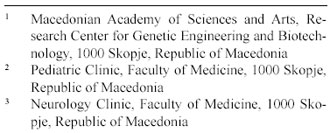


MOLECULAR ANALYSIS OF FRIEDREICH’S ATAXIA
IN MACEDONIAN PATIENTS
Kocheva S1,2, Trivodalieva S1, Vlaski-Jekic S3, Kuturec M2, Efremov GD1,*
*Corresponding Author: Professor Dr. Georgi D. Efremov, Macedonian Academy of Sciences
and Arts, Research Center for Genetic Engineering and Biotechnology, Aven Krste Misirkov 2,
POB 428, 1000 Skopje, Republic of Macedonia; Tel: +3892-120253; Fax: +3892-115434; E-mail:gde@manu.edu
page: 61
|
|
INTRODUCTION
Friedreich ataxia (FRDA), is a progressive neurode generative disorder of autosomal recessive inheritance [1]. It is the most common hereditary ataxia, with an estimated prevalence of 1 in 50,000 [2-4], and a carrier frequency of about 1 in 120 in the Caucasian population [5]. The cardinal feature is gait ataxia followed by upper limb ataxia, cerebellar dysarthria, nystagmus, areflexia, loss of joint position sense and spastic paraparesis [6], developing from the second decade of life. Hypertrophic cardiomyopathy occurs in almost all patients [7], diabetes mellitus in about 10% of patients, carbohydrate intolerance in an additional 20%, and a reduced insulin response to arginine stimulation in all patients [8]. Friedreich’s ataxia is associated with an unstable expansion of a GAA trinucleotide repeat in the first intron of the frataxin gene on chromosome 9q13 [9]. Normal alleles contain five to 60 GAA repeats. The number of repeats in FRDA patients varies from 66 to 1,700, and results in a decreased expression of this gene [9-12], which probably leads to mitochondrial iron accumulation and free radical damage of oxidative phosphorylation processes [13,14]. In about 96% of the patients, both alleles are expanded, while 4% of patients are compound heterozygotes for GAA expansion in the diseasecausing range and an inactivating mutation [9]. Friedreich’s ataxia shows broad clinical variability [15,16]. The Harding diagnostic criteria can be used to differentiate between typical and non typical FRDA cases, but the differential diagnosis from some of the juvenile spinocerebellar ataxias remains a clinical problem. Molecular analysis can be useful to confirm clinical diagnosis and to detect carriers.

|
|
|
|



 |
Number 27
VOL. 27 (2), 2024 |
Number 27
VOL. 27 (1), 2024 |
Number 26
Number 26 VOL. 26(2), 2023 All in one |
Number 26
VOL. 26(2), 2023 |
Number 26
VOL. 26, 2023 Supplement |
Number 26
VOL. 26(1), 2023 |
Number 25
VOL. 25(2), 2022 |
Number 25
VOL. 25 (1), 2022 |
Number 24
VOL. 24(2), 2021 |
Number 24
VOL. 24(1), 2021 |
Number 23
VOL. 23(2), 2020 |
Number 22
VOL. 22(2), 2019 |
Number 22
VOL. 22(1), 2019 |
Number 22
VOL. 22, 2019 Supplement |
Number 21
VOL. 21(2), 2018 |
Number 21
VOL. 21 (1), 2018 |
Number 21
VOL. 21, 2018 Supplement |
Number 20
VOL. 20 (2), 2017 |
Number 20
VOL. 20 (1), 2017 |
Number 19
VOL. 19 (2), 2016 |
Number 19
VOL. 19 (1), 2016 |
Number 18
VOL. 18 (2), 2015 |
Number 18
VOL. 18 (1), 2015 |
Number 17
VOL. 17 (2), 2014 |
Number 17
VOL. 17 (1), 2014 |
Number 16
VOL. 16 (2), 2013 |
Number 16
VOL. 16 (1), 2013 |
Number 15
VOL. 15 (2), 2012 |
Number 15
VOL. 15, 2012 Supplement |
Number 15
Vol. 15 (1), 2012 |
Number 14
14 - Vol. 14 (2), 2011 |
Number 14
The 9th Balkan Congress of Medical Genetics |
Number 14
14 - Vol. 14 (1), 2011 |
Number 13
Vol. 13 (2), 2010 |
Number 13
Vol.13 (1), 2010 |
Number 12
Vol.12 (2), 2009 |
Number 12
Vol.12 (1), 2009 |
Number 11
Vol.11 (2),2008 |
Number 11
Vol.11 (1),2008 |
Number 10
Vol.10 (2), 2007 |
Number 10
10 (1),2007 |
Number 9
1&2, 2006 |
Number 9
3&4, 2006 |
Number 8
1&2, 2005 |
Number 8
3&4, 2004 |
Number 7
1&2, 2004 |
Number 6
3&4, 2003 |
Number 6
1&2, 2003 |
Number 5
3&4, 2002 |
Number 5
1&2, 2002 |
Number 4
Vol.3 (4), 2000 |
Number 4
Vol.2 (4), 1999 |
Number 4
Vol.1 (4), 1998 |
Number 4
3&4, 2001 |
Number 4
1&2, 2001 |
Number 3
Vol.3 (3), 2000 |
Number 3
Vol.2 (3), 1999 |
Number 3
Vol.1 (3), 1998 |
Number 2
Vol.3(2), 2000 |
Number 2
Vol.1 (2), 1998 |
Number 2
Vol.2 (2), 1999 |
Number 1
Vol.3 (1), 2000 |
Number 1
Vol.2 (1), 1999 |
Number 1
Vol.1 (1), 1998 |
|
|

